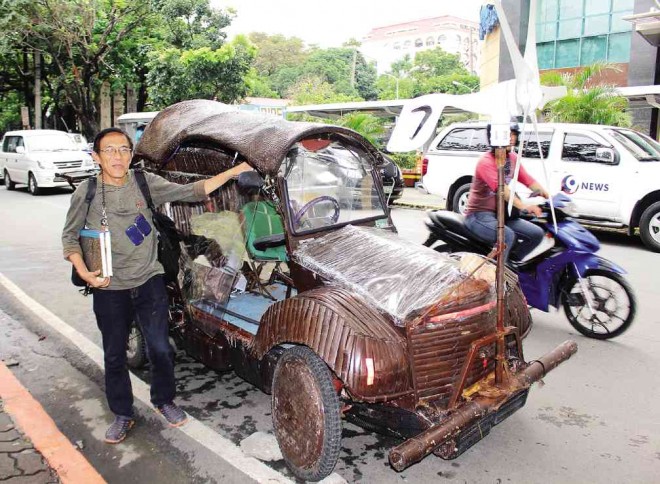
PRIDE IN HIS RIDE History professor Benjamin Mangubat of UP Manila parks his “out-of-the box” creation on Padre Faura Street. JOAN BONDOC
It remains to be seen if it’s really “amphibious,” but it’s certainly ambitious.
A “solar-and-wind-powered” car with a body made of bamboo and other recyclable materials has been a familiar sight at the Manila campus of the University of the Philippines (UP), where its creator reports to work and urges his students to always think out of the box.
The “bangkarwayan”—for “bangka” (boat), car and “kawayan” (bamboo)—is a pet project of Benjamin Mangubat, a 60-year-old history professor at UP Manila.
Mangubat maintains that it is designed for land and water, and runs on electricity generated by solar panels and a windmill. “I want to show my students that I can also walk my talk,” said the professor, who in his class often cites Dr. Jose Rizal, the national hero, as a model of inventiveness and creative thinking that his students can emulate.
“I want to inspire my students to think out of the box but… many of them are simply book-learning,” he said in an interview Friday.
The bangkarwayan, which can accommodate up to six people, is about the size of a subcompact car, its dark brown coat giving it a retro look. It has a “banig” (native sleeping mat) for a roof and “bilao” (winnowing baskets) for hubcaps.
On land, the vehicle can reach 40 kilometers per hour, drawing power from two sets of five 12-volt batteries, he said. There is a second set of batteries for reserve power.
Since its completion in February, Mangubat has driven it around Manila—the Land Transportation Office not requiring it to be registered. He hopes to take it all the way to UP Diliman campus in Quezon City next week.
But Mangubat admitted that he had yet to test bangkarwayan in the water—perhaps in the next major flood that will hit the metropolis— to really prove its amphibious side.
Still, the vehicle appears equipped to make a splash: It is fitted with empty plastic bottles for floaters, a rudder, a propeller, and a separate, smaller engine to power it as a boat.
“It has become a ‘traveling Meralco,’ with enough electricity to run three electric fans, a fridge, several LED lights and a TV,” Mangubat said of the transport which took him six years to build. He earlier tried several models, with the latest costing him about P200,000.
His efforts began in 2008, the UP centennial year, with a 30-foot long boat made mostly of styrofoam. It was tested on Manila Bay but rising costs prevented him from making further improvements.
But past failures only prodded him to look for more feasible designs—and eventually find a team of helpers. For bangkarwayan, he hired two technicians and a 77-year-old carpenter to put it all together. None of them had any background in automotive engineering but relied only on the professor’s online research.
“I display the bangkarwayan outside the UP Manila campus as a way of telling people that this is how we’re going to source energy later on. You’re looking at the future with solar panels and windmills, so in a way I’m educating people.”
“It’s also about resilience,” he added. “A lot of people got burned out doing what they wanted to do, such as Charles Goodyear, the man who created tires. Because I’m a teacher, this is also my way of teaching my students about resilience.”

